Death Scene Investigations in Southern Maryland
by J. Thomas McClintock, Ph.D.
Forensic entomology is the study of the use of insects in the field of forensic science as it pertains to the investigation of human and animal deaths and abuse, food and other product contamination, thefts, the illegal drug trade and unethical entomological practices. Many common questions arising from a crime scene investigation can be answered through the use of forensic entomology. Such questions include the time of death or postmortem interval (PMI), movement of a body from one location to another, determination of environmental conditions to which a body has been exposed, location of traumatic wound sites, and identification of toxicological deaths. Moreover, the degree of the field’s applicability to military and intelligence analysis is not known.
In order to better understand some of these questions associated with the use of insects in a crime scene investigation in Southern Maryland, DNA Diagnostics, Inc. created a “mock” death scene by using pigs as proxies for human cadavers. This study was designed to provide information on how the rates of decomposition for estimating the time of death (or PMI) is affected by the local climate (in September and October) in Southern Maryland, as well as, information about the insect activity and developmental time for these necrophagous insects (i.e., insects that feed on decomposing corpses and carcasses by consuming the flesh) in this region. The use of insects for legal investigations is not new, however, information available on forensic entomology is often minimal and, in some instances, these silent witnesses are valuable pieces of evidence that are often ignored.
To study the process of decomposition, a study site was set up to contain 2 test subjects (Sus scrofa). The site was visited regularly to observe the decomposition process, evaluate the rate of decay, collect insect samples, and maintain the facility. Detailed notes and photographs were taken during each site visit to document any changes to the specimens, insect activity and weather patterns. Temperature data, collected from the Arbor Green weather station (Owings, MD), was used to calculate the accumulated degree-days (ADD) to estimate the PMI. All insects collected were identified and analyzed for patterns of insect succession.
The study site for this research project was situated on the eastern bank of the Patuxent River (Lat. 38.7°N Long. 76.6°W) located less than one mile west of the city of Lower Marlboro, MD. The geographical area surrounding Owings is best described as the coastal plain of Southern Maryland with an elevation of approximately 102 feet. Vegetation of the area included a forest canopy on three sides of the site and surrounding the wire enclosure comprising sweet gum (Liquidambar styraciflua), wild cherry (Prunus spp.), cedar (Juniperus spp.) and various varieties of oak (Quercus spp.) and pine (Pinusspp.). The terrain is flat and the field vegetation includes grasses, wild blackberry, and poison ivy. Small to mid-scale scavengers included buzzards, squirrels, fox, voles, and mice. Large herbivores included deer and turkeys.
For this study, two pigs (Sus scrofa) were used as proxies for human cadavers. Pigs are often used as substitutes for human specimens because of many similar biological characteristics with humans (i.e., similarity of organ tissues and structure, comparable skin thickness, amount of body hair, and gut fauna). Previous insect succession and decomposition studies have utilized pigs as proxies for human cadavers (Payne, 1965, Anderson et al., 1996, and Bunch (2009). The pigs, identified as Stewart and Scrappy, were acquired from an Amish farmer located south of Mechanicsville, MD. Time of death for Stewart was recorded at 2:00 PM on September 4, 2010 by a .22 caliber gunshot wound to the central forehead. Stewart weighed 16.78 kg (37 lb) and measured 86.36 cm (34 in) from the snout to the rump. Stewart was placed at the site at 3:37 PM on Saturday, September 4, 2010. Time of death for Scrappy was recorded at 2:01 PM on September 4, 2010 by a .22 caliber gunshot wound also to the central forehead. Scrappy weighed 4.54 kg (10 lb) and measured 56.52 cm (22¼ in) from the snout to the rump. Scrappy was placed at the site at 3:46 PM on Saturday, September 4, 2010. Weather conditions at the time of placement was sunny, 26.9°C (80.5°F), and slightly breezy (12 mph W).
Both pigs were placed in a wire (galvanized welded wire 14 gauge) enclosure (see Figures 1 and 2) that measured 101.6 cm x 121.3 cm x 81.3 cm (40 in x 48 in x 32 in). However, prior to placement the smaller pig was clothed in a one-piece cotton body suit as a potential deterrent to insect colonization. The enclosure was built to encase both pigs to prevent carnivore activity and avian predators and scavengers (e.g., buzzards). Data and information for both pigs were visually observed, collected, and recorded once a day for 11 days of insect succession and rate of decomposition due to the high temperatures. The final site visit was conducted on September 25, 2010.

Figure 1. Top view of 101.6 cm x 121.3 cm x 81.3 cm (40 in x 48 in x 32 in) enclosure with both pigs, Steward (top) and Scrappy (bottom), and pit fall traps (circles).
Three pit fall traps were placed inside the enclosure and on the outside perimeter of the pigs. The pit fall traps were constructed using a 1-liter soda-pop plastic bottle cut in half with the top placed upside down in the bottom half of the bottle to create a funnel. A cup of antifreeze was placed in the bottom of the traps to “preserve” the trapped insects (see Figure 1).
Data collected during each visit included adult insects and larval samples, photographs of both carcasses, temperature at the site and from Arbor Green weather station. All specimens were labeled and stored in a cool environment until identified using a dissecting microscope.
The observations and results presented below are a compilation of visual observations obtained from visits to the site and weather data recorded from Arbor Green weather station. The visual observations serve to describe the state of decomposition and insect succession of both pig specimens. The temperature data recorded from the Arbor Green weather station was used to calculate the time of death for each specimen.
Fresh Stage
Both pigs, Stewart and Scrappy, were placed at the site on September 4, 2010 (Figure 2). The fresh stage of decomposition began on this date (Day 1) and continued until

Figure 2. Day 1, both pigs were placed at the site on September 4.
the end of Day 2 (Figure 4) when the carcass began to bloat (Day 3) for the largest pig. The smaller pig, Scrappy, was clothed in a one-piece cotton bodysuit (e.g., for a 0-6 month old infant) and did not begin to bloat until Day 4. The weather conditions on the day of placement were hot and dry with temperatures ranging from 14.4°C to 28.8°C (58°F to 84°C) with high relative humidity (29% to 87%). Days 2 and Day 3 were nearly identical with temperatures ranging from 10.6°C to 28.3°C (51°F to 83°F) with higher relative humidity (28% to 97%). Immediately upon placement of the first pig flies (Family: Calliphoridae; Figures 3, 5, and 6) were attracted to the carcass. Other insects present included leafhoppers and several dragonflies (Family: Coenagrionidae).




Figure 3. Various adult Calliphorids flies that were observed at the test site.
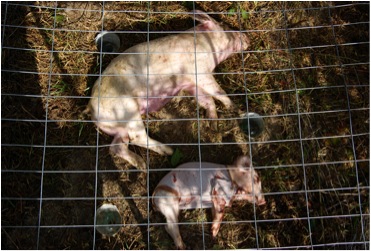
Figure 4. Day 2, September 5, of Stewart (top) and Scrappy (bottom).

Figure 5. Day 2, Calliphorids were observed on the carcasses of both pigs in search of an oviposition site (see top and center) of photograph.

Figure 6. Day 2, a Calliphorid searching for an oviposition site
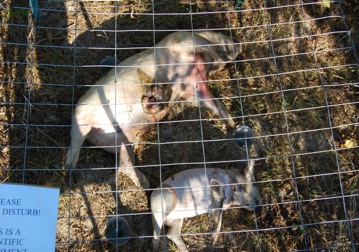
Figure 7. Day 4, September 7, Stewart (top) and Scrappy (bottom) have entered the bloat phase of decomposition characterized by the discoloration (bright pink) of the body.
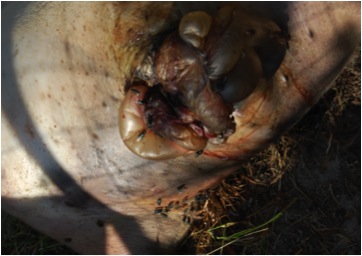
Figure 8. Day 4, September 7, Stewart (top) and Scrappy (bottom) have entered the bloat phase of decomposition characterized by the discoloration (bright pink) of the body.

Figure 9. During the bloat phase, the abdominal region has inflated and “balloon-like” as pressure from the gases produced by decomposition builds up in the cavity.
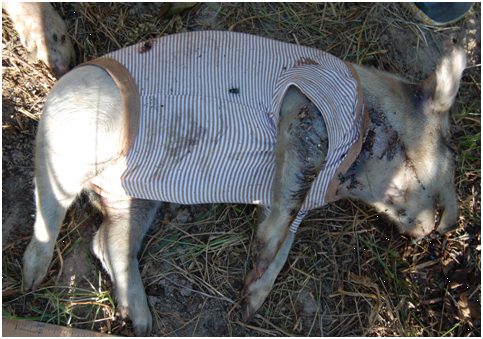
Figure 10. The bloat phase of the smaller and clothed pig was not outwardly visible and occurred about 1 day later than the large pig. Discoloration had occurred revealing a blue color around the neck and upper abdominal region.
Early Decomposition
Day 3 and 4, September 6 and 7, 2010 marked the end of the fresh stage and the beginning of the early decomposition stage for both pigs, which lasted until Day 5 and 6, September 8 and 9, 2010, respectively for both pigs (Figure 7). This stage is characterized by discoloration of the body (Figures 7 and 9), bloating and purging of decompositional fluids, and a period of post bloating after the release of abdominal gasses. On Day 3, the large pig’s carcass was fully bloated with decompositional fluids purging slightly from the mouth, nose, and from exposed (or pushed out) visceral organs from the belly and anus on Day 4 (Figures 7 and 8). Several adult burying beetles (Nicrophorus spp.) were observed at the interface between the abdominal cavity and the ground (Figure 11). Also, Staphylinids (rove beetles) and American carrion beetles (Family: Silphidae) were observed (Figure 15). Scrappy was fully bloated by Day 5. The skin on the abdominal region of Stewart was pink, blue to purple, and “marbled” in appearance. Since Scrappy was clothed discoloration of the skin was not as easily observed. A large mass of adult green and blue bottle flies and blow flies from the family Calliphoridae such as Phormia regina and Lucidia illustris were prevalent on the interface of the belly and ground as well as on the mouth of Stewart. There was no visible sign of fly eggs or fly larvae but hundreds of adult Calliphorid flies were resting on the branches of shrubs and trees surrounding the wire enclosure. Adult Muscidae flies were present along with adult American carrion beetles and rove beetles on and around both carcasses. Odor associated with this stage was mild and characteristic of decomposition and “traveled” approximately 2 – 5 yards from the site.



Figure 11. Several adult burying beetles (Nicrophorus spp.) were observed at the interface between the abdominal cavity and the ground of both pig carcasses.
Advanced Decomposition
Advanced decomposition began on Day 5 (September 8, 2010) for Stewart and Day 6 (September 9, 2010) for Scrappy and lasted until skeletonization (Figures 12, 13, and 14). The decomposition stage is characterized by the sagging of flesh and the collapsing of the abdominal cavity. Due to the dry environment, mummification of the skin occurred. On the later part of Day 5, the abdominal cavity “caved in” and the skin began to sag on both pigs. A large larval mass was visible around the edge of the carcass of the larger pig (Stewart) and appeared to be attempting to gain access to the inside of the carcass. The skin of both pigs was hard and dry with a leathery texture. Most of the hair from the carcasses had fallen off and remained in “balls” of tuff. Skin of the head, neck, chest, and shoulder regions continued to peel and flake off. The carcasses continued to darken and dry out especially on the head, neck, legs, ventral portion of the abdomen and dorsal portion of the trunk.
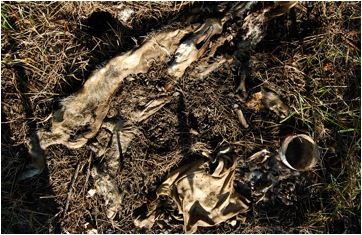
Figure 12. Day 10, September 13, of Stewart (top) and Scrappy (bottom). The large maggot mass has moved from the carcasses. The soft tissue and cartilage has been removed leaving bones

Figure 13. Day 10, September 13, of Scrappy. The large maggot mass has moved away from the carcass leaving hair and bones and the item of clothing.

Figure 14. During the skeletonal stage, only hair and bones are left on the carcasses.
The most notable areas of drying included the ears, mouth, nose, and eyes. The maggot activity began to change, as the masses appeared to slightly reduce in size and moved out from the carcasses. On Days 6 and 7, Staphylinidae beetles and an abundance of American carrion beetles (Silphidae) were present and remained with the carcasses until Day 11, September 15, 2010 (Figure 15). However, their numbers
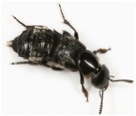
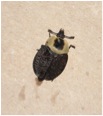
Figure 15. Many Staphylinids (left) or rove beetles and Silphids (right) or American carrion beetles were observed during both the early and advanced decomposition stages.
declined significantly after a day of steady rainfall on Day 9. During this day of rain, an abundance of individual fly larvae (later instars) had surfaced and were moving vigorously over the abdominal region of Stewart. From day 11 to Day 15, September 18, 2010, there was a significant decline in odor and the maggots had moved away from the carcasses to burrow into the soil to pupate.
The results presented in this study, although preliminary, provides valuable, never before tested information about the decomposition process in Southern Maryland. Data collection in this study is extremely important to understanding the complex process of decomposition. Temperature and humidity are related to all aspects of decomposition and influence the succession of insects and their behaviors when visiting carrion. Although this study reflects a controlled test environment, an unknown component to the research is made available on decomposition rates and shows that although variable, temperature is the number one factor in the rate of decay in deceased individuals.
REFERENCES CITED
Anderson, G.S. and S. L. VanLaerhoven. 1996. Initial studies on insect succession on carrion in southwestern British Columbia. J. For. Sci. 41(4):617-625.
Bunch, A.W. 2009. The impact of cold climate on the decomposition process. J. For. Identification. 59 (1): 26-44.
Payne, J. A. 1965. A summer carrion study of the baby pig Sus scrofa [Linnaeus]. Ecol 46:592-602.
http://www.washingtonpost.com/wp-dyn/content/article/2010/11/01/AR2010110106340.html
http://www.somdnews.com/stories/10272010/recmor135519_32371.shtml
http://cos.gmu.edu/news/course-news/bugged-biology-insects-help-students-solve-forensic-mysteries